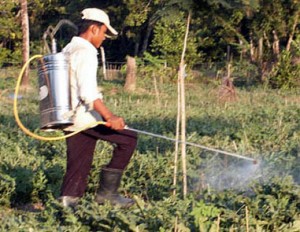By Margaret Morales
In my last post I wrote about some of the health risks of pesticide exposure. The risk of exposure is particularly high for agricultural workers and others who work directly with pesticides. In 1992 the EPA published the existing Worker Protection Standard (WPS) for Agricultural Pesticides which outlined measures meant to protect employees at commercial agricultural establishments (farms, nurseries, greenhouses, etc.) and pesticide handling establishments.
The EPA estimates that there are approximately 2 million agricultural workers and pesticide handlers working at over 600,000 locations across the US. About 900 million pounds of pesticides are used annually in the US, with over 800 of these applied in commercial agriculture or public settings.

Little tracking is done regarding worker illnesses from pesticides. The EPA states that 10,000-20,000 physician-diagnosed pesticide poisonings occur in the US annually. However, this number dates back to a study conducted in 1997; many other studies suggest that the number is actually much higher due to underreporting, misdiagnosing, and a lack of tracking.
Updating the WPS
In February of this year the EPA proposed a series of updates to the Worker Protection Standard. Some of the proposed changes reflect increased precautions surrounding pesticide handling and exposure. These changes include:
- Required annual pesticide safety trainings for workers and handlers
- Current standards require training only every 5 years
- A minimum age requirement of 16 for pesticide handlers, though family-farms are excluded from this requirement
- The current WPS lists no minimum age requirement for these jobs
- The creation of 25-100 foot buffer areas surrounding fields during pesticide application
- Buffer requirements currently apply only to nurseries and greenhouses
- The adoption of OSHA standards for respirators, including proper fitting, medical evaluations, and training
- Currently employers only have to provide respirators as listed on the pesticide label
The proposed changes would also relax regulations in some ways, including:
- Revoking the requirement to post information regarding pesticide applications in a central display at the farm or establishment
- Current standards require that information be posted in a central display for at least 30 days following a pesticide application event
- Expanding the definition of ‘immediate family’ to include grandparents, grandchildren, and in-laws. Family-owned farms employing only immediate family members remain exempt from most WPS requirements.

Concerns about the Proposed Changes
While the proposed changes will lead to greater protection for farmworkers, many advocacy organizations are suggesting that they do not do enough. One major concern is that pesticide labels and information sheets are still only required to be printed in English. This makes the information inaccessible to many farmworkers who do not speak English; in a recent survey conducted by the National Center for Farmworker Health, 35% of hired farmworker respondents said that they did not speak any English. Only 30% said they could speak English well.
In addition, though the proposed changes include more frequent safety trainings, there is no regulation regarding what training must entail. Advocates from United Farm Workers say that training often consists of watching a short, general video at the end of the work day, with no time for questions.
Many organizations, including Farmworker Justice, are also concerned about losing the requirement that information announcing pesticide applications be posted in a central location at all establishments. Although the information is required to be accessible if an employee asks for it, there is concern that many, particularly migrant workers, may not feel comfortable making this request.
Finally, the lack of age limits for workers on family farms is a concern for some advocacy groups. Workers at family owned farms may make up as much as 2/3rds of the nation’s agricultural labor force. As these farms are exempt from much of the WPS, this leaves a lot of agricultural workers unprotected.
Many advocates are also calling for additional measures to be added to the proposed changes. Among these is medical monitoring for farmworkers and pesticide handlers who deal with organophosphate and N-methyl carbamate pesticides, two of the more toxic pesticide classes. Measures such as optional blood testing could help to catch overexposure before illness occurs. Washington and California have already implemented similar programs and have noticed considerable reduction in poisoning reports.
Organophosphates, which include some of the most toxic pesticides, are studied in two of Duke’s Superfund Research Center’s projects, so we’re keeping our eye on these developments. There is currently no national standard for reporting pesticide application; California is the only state to mandate detailed reporting on pesticide usage on commercial farms. In addition, only 30 states require health professionals to report pesticide poisonings. This lack of information poses a significant obstacle for researchers and public health professionals interested in evaluating health risks from pesticides, or the effectiveness of existing safety measures. We’re looking forward to seeing what happens as the WPS evolves this year.
The comment period on the proposed changes has been extended until August 18th of this year. If you or your organization would like to comment on these changes, you can find out how to do so here.




